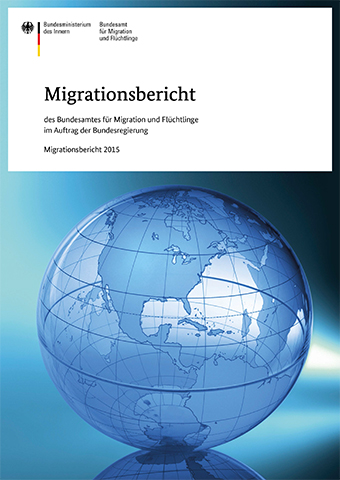The 2015 Migration Report ,

The 2015 Migration Report, drawn up by the Federal Office for Migration and Refugees, was presented by Federal Ministry of the Interior on 14 December 2016. In addition to comprehensive data on migration regarding Germany, the Report contains a European comparison on migration-related events and on asylum-related immigration. It addresses the phenomenon of irregular migration and provides information on the structure and development of the population with a migration background.
Major results
- 2015 was characterized by the highest level of immigration of individuals seeking pro-tection. 476,649 asylum applications (first and subsequent asylum applications) were registered in 2015 (in comparison to 202,834 asylum applications in 2014). This amounts to an increase of 135.0 per cent in comparison to the preceding year.
- According to the EASY quota system (Initial Distribution of Asylum-Seekers) initially as many as 1,091,900 arrivals of asylum seekers were registered. However, errors in counting and double counting, as well as onward- or return travels could not be ex-cluded when registering in the EASY quota system, since no personal data is recorded in EASY. Only after the completion of the post-registration in September 2016 it be-came clear, that the number of arrivals was indeed 890.000.
- 2015 witnessed the highest level of immigration and the highest positive migration balance since 1992. In comparison to the previous year, immigration increased by 46 per cent to 2.14 million arrivals. The number of those moving away rose by 9 per cent (approx. 1 million); the migration surplus is 1.14 million persons.
- The number of asylum-seekers reached a historical record in 2015. In this context, an increase of the indicators of irregular migration has been observed.
- In the year 2015, Syria was the main country of origin of immigrants with 326,900 Syrians arriving in Germany, which was by far the largest group of immigrants. This is due to the disproportionate increase in asylum-related immigration within this group of persons. This also applies to the strong immigration from Afghanistan, Iraq and Pakistan.
- Internal EU migration remains strong, as it constitutes 39.6 per cent of the whole im-migration to Germany. Although Germany has registered an increase in the arrival of Union citizens, the share of the internal EU migration within the entire immigration is declining due to the disproportionate increase in asylum-related immigration.
- With 99.100 students the highest number of young people who received their entry qualification in a country other than the country they are currently studying in started studying in Germany.
- Family reunification increased by 44 per cent in comparison to the preceding year.
- Germany remains the main destination country for migrants in European comparison.
- One fifth of the population has a migration background. Among children under the age of ten, about one-third has a migration background.
- In 2016 immigration to Germany declined. This is mainly due to the decline in asylum-related immigration since early 2016.
The Federal Government's Migration Report is published on an annual basis by the Federal Office for Migration and Refugees.
The Migration Report is only available in German.

